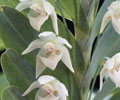|
|
|
|
|
| |
Flasks of
Dichaea glauca 'MC2225' × self |
|
| |
|
|
| |
| Number: |
TN3912 |
| Name: |
Dichaea glauca 'MC2225' × self
|
| Type: |
self (What's that?) |
|
Seed Donor: |
Troy C. Meyers
|
|
Click to Enlarge

Pod Parent Closeup of Flowers |
Click to Enlarge

Pod Parent Flowers |
|
|
|
| |
Culture Notes from Donor: Parent plant: Temperature range I (60-83°F)
Comments: Parent plant: Flowers are fragrant. Medium-sized plant. This individual is supposedly from Mexico.
For additional origin/habitat information supplied courtesy of
Charles and Margaret Baker, see further below, near the bottom of this page.
|
Temperatures we attempt to use in the lab & greenhouse:
| For Species: |
|
Summer, Autumn: days average 78°F, nights 62°F; best fit is Intermediate 83-60°F
(Source:
Baker's Web OSC) |
| For Species: |
|
Spring: days average 81°F, nights 59°F; best fit is Intermediate 83-60°F
(Source:
Baker's Web OSC) |
| For Species: |
|
Winter: days average 75°F, nights 56°F; best fit is Cool-Intermediate 75-58°F
(Source:
Baker's Web OSC) |
|
About the name...
| Etymology of |
Dichaea |
|
From Greek "diche" double; from the typical foliage growing in two opposite rows.
(Source:
Mayr & Schmucker 1998) |
| Etymology of |
glauca |
|
From latinized Greek "glaucus" shining blue-green.
(Source:
Mayr & Schmucker 1998) |
| Pronunciation of |
Dichaea |
|
dir-KEE-ah
(Source:
Pridgeon 1992) |
| Pronunciation of |
glauca |
|
GLAW-ka
(Source:
Hawkes 1978) |
|
If you would like to direct someone to this web page, please copy and paste this URL into your email:
http://troymeyers.com/d?013912
| Flask Information |
| Availability: |
Capsules failed. We were not able to make any flasks. |
| You should: |
Consider placing a "Notify Retries" Request, and if an identical pollination (the same parents) is done again, we'll let you know. |
|
You might also want to:
|
View items of the same species.
View items of the same genus.
|
| Ordering Information |
| You are not currently logged in. |
|
You must be a registered user and be logged in to reserve a flask or place a notification request. Please log in:
|
|
|
|
|
|
| |
The origin/habitat information below is supplied courtesy of Charles and Margaret Baker
The following information is based on the name of the plant provided by the donor, and assumes that the name is correct. If the plant has been misidentified, then the following information may not be correct.
This text is copyrighted by the Bakers and may not be reproduced without permission.
ORIGIN/HABITAT: Mexico south through Guatemala, Honduras, El Salvador,
Nicaragua, Costa Rica, Panama, and extends eastward to the islands of
Cuba, Jamaica, and Hispaniola. In Mexico, this orchid is found on both the
eastern and western slopes of the dividing mountain range in the states of
Hidalgo, Puebla, Veracruz, Guerrero, Oaxaca, and Chiapas. Plants grow
attached to trees, rocks, or the surface of the ground. They most often
grow on trees in habitats as varied as mountain rainforest, pine-oak
forest, cloudforest, tropical semideciduous forest, oak forest, and coffee
plantations at 2300-6550 ft. (700-2000 m). In Guatemala, plants usually
grow on trees in wet forests at elevations up to 7850 ft. (2400 m), but
they are occasionally found on rocks or on the ground. In Nicaragua, this
orchid grows both on rocks or in moss on the forest floor in dense, wet
cloudforest near Matagalpa and Jinotega at 3300-4600 ft. (1000-1400 m).
More about this information and the Bakers...
|
|
|
| |
|
|
|